#Paul-Émile Victor
Explore tagged Tumblr posts
Text
Outside, the wind and the sea. Within me is joy.
Paul-Émile Victor, Diaries 1936-1937
#paul émile victor#paul-émile victor#polar expedition#polar explorer#polar exploration#polar history#north pole#arctic exploration#arctic#greenland
10 notes
·
View notes
Text




📌 [ÉCHO] Comme un certain PEV, j'en ai pour 500 ans de projets ! Ma première BD 💬 est enfin finalisée. Son titre ? « Le souffle de l’aventure ». C'est le tome 1 d'une série inédite consacrée à Paul-Émile Victor (tiens, tiens !). Un album en précommande à tarif préférentiel. Soutenez-nous.
Pour en savoir + 👇
#bd#polaire#explorateur#paul-émile victor#éditions du sekoya#stéphane niveau#stéphane dugast#laurent seigneuret
2 notes
·
View notes
Text
c'est trop drôle paul-émile victor se faisait appeler pev comme un normalien en 2024
4 notes
·
View notes
Text

Photograph of the world's most famous gathering of scientists recreated in color:
This image is of the 5th Solvay Conference on Electrons and Photons. Held in 1927, it is widely regarded as one of the most notable gatherings of scientific minds in history
Now, the event has been brought to life in color.
The conference was attended by 29 of the world’s leading physicists, 17 of whom would go on to win Nobel Prizes. Among these luminaries were legendary figures like Albert Einstein and Niels Bohr, whose groundbreaking work shaped modern physics.
Here are the attendees (in order of appearance in the image)
• Peter Debye
• Irving Langmuir
• Martin Knudsen
• Auguste Piccard
• Max Planck
• William Lawrence Bragg
• Émile Henriot
• Paul ehrenfest
• Maria Skłodowska-Curie
• Hendrik Anthony Kramer
• Edouard hearts
• Hendrik Antoon Lorentz (Presidente)
• Théophile of donder
• Paul dirac
• Albert Einstein
• Erwin Schrödinger
• Arthur Holly Compton
• Jules-émile verschaffelt
• Paul Langevin
• Louis-Victor de broglie
• Charles-eugène guye
• Wolfgang Pauli
• Werner Heisenberg
• Max Born
• Charles Thomson Rees Wilson
• Ralph Howard Fowler
• Léon Brillouin
• Niels Bohr
• Owen Willans Richardson
• William Henry Bragg (absent in photo)
• Henri-Alexander Deslandres (absent in the photo)
• Edmond Van Aubel (absent in photo)
2 notes
·
View notes
Text
I've been going on something of a mini-dive into the Franco-Prussian War. It really hasn't been on my radar, although increasingly I come across it (thanks Victor Hugo I guess)—and as a piece of trivia Paul Gavarni's son Pierre, who painted as Pierre Gavarni, was awarded Chevalier de la Légion d'honneur for his actions during the war (I have no information about what he did).
"The Franco-Prussian War: Depicting defeat" is a fantastic series of blog posts that I've found, focused on art of the war. Émile Betsellère's L’Oublié (The Forgotten) is absolutely devastating.

(The artist's model for this painting was an actual soldier in the conflict who was injured and abandoned on the battlefield, Théodore Larran, who later married the nurse who saved his life.)

In the Trenches (1874), by Alphonse de Neuville. You look at scenes like this and all those people around the turn of the 20th century who said a huge war could NEVER happen again sound a hundred times more demented.
#franco prussian war#1870s#military history#art#émile betsellère#alphonse de neuville#anyone know where i can find Dossier Léonore 19800035/189/24642?#for pierre gavarni
46 notes
·
View notes
Text

Paul-Émile Botta and Victor Place next to one of the statues at the gate of the Citadel Of Sargon II in Khorsabad, Iraq.
0 notes
Text
Musée d'Orsay
Museum in Paris

The Musée d'Orsay is a museum in Paris, France, on the Left Bank of the Seine. It is housed in the former Gare d'Orsay, a Beaux-Arts railway station built between 1898 and 1900. The museum holds mainly French art dating from 1848 to 1914, including paintings, sculptures, furniture, and photography.
Address: Esplanade Valéry Giscard d'Estaing, 75007 Paris
Phone: 01 40 49 48 14
Stories from the collection: From Station to the Renovated Musée d'Orsay
Founded: 1986, Paris
Architects: Gae Aulenti, Victor Laloux, Émile Bénard, Lucien Magne, Jean-Paul Philippon, Pierre Colboc, Renaud Bardon
Architectural style: Beaux-Arts architecture
Founder: Valery d'Estaing

The Ballroom - Musée d'Orsay, Paris
Photographed by Freddie Ardley - instagram
2K notes
·
View notes
Text
0 notes
Text
Une impressionniste oubliée sort de l’ombre au musée de Pont-Aven : Anna Boch
Arts et Expositions
Par Guy Boyer le 06.02.2024
Montée avec le musée d’Ostende, l’exposition consacrée à la femme peintre et collectionneuse Anna Boch (1848-1936) permet de découvrir cette figure méconnue de la période impressionniste et postimpressionniste venue en Bretagne en 1901 et 1912.
Premier événement à bénéficier de la générosité du musée d’Orsay en parallèle à l’exposition « Paris 1874. Inventer l’impressionnisme » (du 26 mars au 14 juillet), l’exposition « Anna Boch. Un voyage impressionniste » au musée de Pont-Aven, jusqu’au 26 mai, met au cœur de son parcours le Portrait d’Eugène Boch de Vincent Van Gogh (1853-1890) prêté par le musée parisien. Cette œuvre importante souligne les liens de cette famille belge avec l’avant-garde des années 1890 et leur goût de la collection.
Collectionneurs de Van Gogh, Gauguin, Marquet
L’exposition commence par la carrière de peintre d’Anna Boch, de ses débuts en Belgique jusqu’à ses voyages en Bretagne et dans le Sud de la France. Malgré certaines œuvres assez faibles, le corpus de cette artiste méconnue surprend par certains éclairs de génie et plusieurs emprunts à ses contemporains comme Segantini ou Valtat. Vient ensuite une section dédiée à ses différentes demeures et ses commandes à des artistes Art Nouveau comme Victor Horta (une réussite) et Maurice Denis (un échec). L’un des chapitres les plus passionnants reste celui consacré à ses collections artistiques puisqu’Anna Boch et son frère Eugène possédaient des Ensor, Gauguin, Van Gogh, Émile Bernard, Paul Signac, Henry Moret et Albert Marquet.
Une fortune de faïence
En Belgique, le père d’Anna Boch est célèbre car il est le fondateur de la société de faïencerie Boch frères (antenne belge de Villeroy & Boch). La famille vit confortablement dans le château de La Closière, près de La Louvière. Dès les années 1870, Anna Boch décore des plaques, plats et assiettes en camaïeu de bleus. Dans ces premières créations de céramique, on peut retrouver des traces de sa formation auprès d’Isidore Verheyden, un peintre de plein air (ne pas manquer son incroyable portrait par Anna Boch, où on le voit penché sur un tableau posé en biais).
Avec le groupe des XX
Dès 1885, Anna Boch rejoint le salon des XX, un cercle artistique fondé par son cousin Octave Maus, où exposent James Ensor et Jan Toorop mais aussi une quantité d’invités étrangers. C’est là qu’elle voit les dernières nouveautés artistiques, du divisionnisme de Segantini au pointillisme de Seurat. On reconnaît dans le travail d’Anna Boch une solidité de la composition (ici le reflet du bouquet de fleurs dans un miroir) et une harmonie des couleurs.
Une famille voyageuse
Aimant se déplacer facilement, Anna Boch achète une Minerva en 1907. On la voit ici, à bord de l’automobile, parmi les paysages du Midi de la France. Deux tableaux superposés permettent de comparer son style et celui de son frère. Devant un même paysage méditerranéen surmonté d’une tour sarrasine, on voit leurs approches différentes. Lui (en haut) schématise la composition, elle (en bas) joue des effets de matières et de couleurs. Même le chauffeur, Albert Lepreux, est de la partie et plante son chevalet avec eux dans la nature, de la Normandie au Maroc.
La Bretagne en deux temps
En 1901 et en 1912, la troupe sillonne la Bretagne. De Bénodet à Carhaix, Anna Boch en ramène des paysages maritimes. Aux plages des bords de l’Odet du premier séjour succèdent les falaises et rochers de la Bretagne du nord. Les grands formats panoramiques sont ensuite remplacés par des toiles au cadrage resserré.
Des commandes aux artistes
C’est l’architecte belge Art Nouveau Victor Horta qui restaure en 1895 la villa d’Anna Boch dans le quartier de Saint-Gilles à Bruxelles. Huit ans plus tard, la commanditaire déménage dans une maison construite par Paul Hermanus à Ixelles, où elle fait transporter le décor de Horta, cheminée comprise. Elle imagine également un grand décor qu’elle confie à Maurice Denis mais devant toutes les allégories antiques que celui-ci propose, elle préfère renoncer.
En pleine nature
L’exposition se conclue par une section plus faible consacrée aux liens d’Anna Boch avec le groupe de peintres luministes Vie et lumière. Les scènes bucoliques de ramasseurs de glands ou de ramendeuses de filets, qu’elle réalise alors, perdent en nervosité et en contrastes colorés. Pourtant, c’est l’époque d’une certaine reconnaissance publique en France puisqu’elle expose à la galerie Druet en 1908. Dans les années 1930, elle organise le devenir de ses collections, donnant plusieurs œuvres aux musées royaux des Beaux-Arts de Belgique ou au musée d’Ixelles.
https://www.connaissancedesarts.com/arts-expositions/impressionnisme/une-impressionniste-oubliee-sort-de-lombre-au-musee-de-pont-aven-11189177/
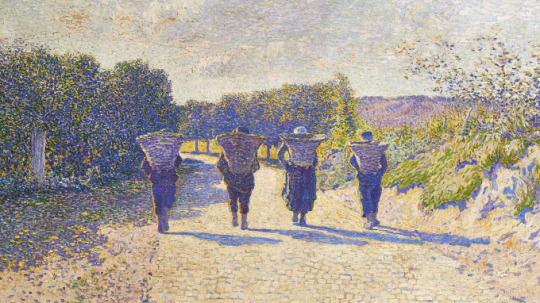


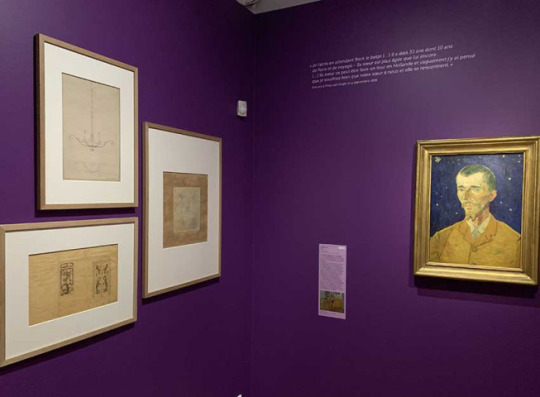



#france#brittany#breizh#bretagne#aesthetic#artists on tumblr#artistsoninstagram#artistsupport#meet the artist#painter#impressionistpainting#impressionistart#french impressionist#impressionistic#impressionism#orsay#louvre#met museum
0 notes
Text

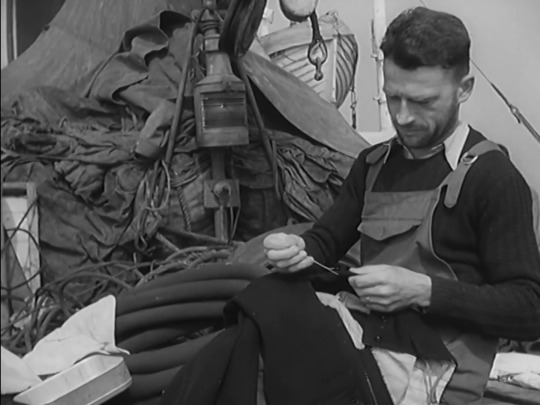
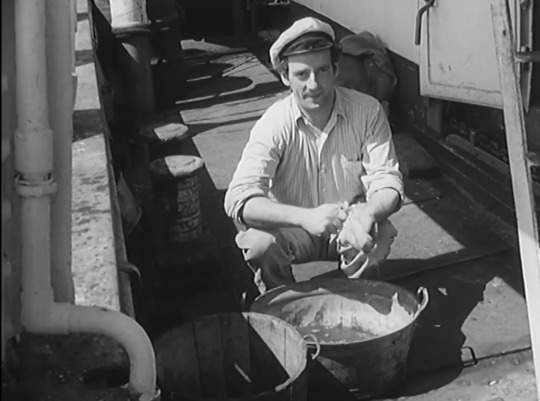
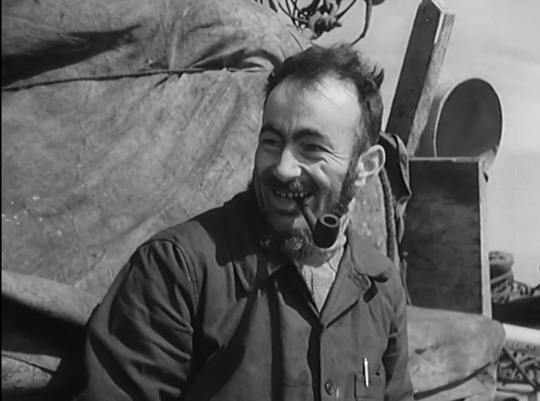
Members of the first French polar expedition as they sail towards Greenland, 1949 (from the documentary Ice Land).
#terre de glaces#polar exploration#polar expedition#polar explorers#paul-émile victor#paul émile victor#arctic exploration#greenland#groenland#north pole#this was an amazing watch - very genuine as well a very well-shot#really recommend it#boat media
4 notes
·
View notes
Text
📌[ÉCHO] Une #bd 💬 un destin ✨ Paul-Émile Victor, l’exploration hier, aujourd’hui et demain…
0 notes
Text
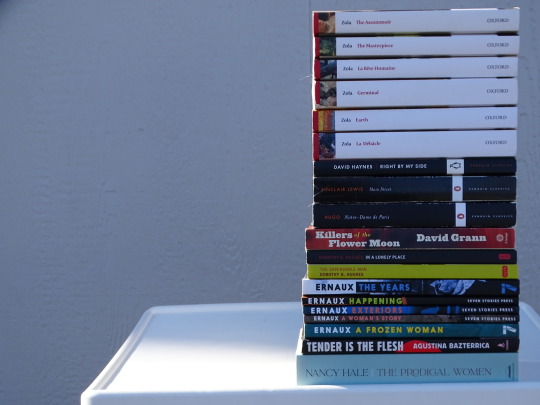
Top Ten Favorite Reads of 2023
I read 80 books this year and throughout the year I had three contenders for what I thought was the best book read. And then it dawned on me, there was only one real choice. This year, as I have done many years in the past, I grouped more than one book together by the same author for Best Book of The Year. And that can only mean one person: Émile Zola.
#1
The Assommoir Émile Zola (1877)
The Masterpiece Émile Zola (1886)
La Bête Humaine Émile Zola (1890)
Germinal Émile Zola (1885)
Earth Émile Zola (1887)
La Débâcle Émile Zola (1892)
Without going overboard on my descriptor Zola wrote 20 books known as the Rougon-Mcquart series which documents these two families over five generations and how mental illness and alcoholism effect their bloodline. There is no way I could distinguish a ranking for these six Zola novels, all great, all devastating and all memorable. In The Assommoir we see how alcoholism and poverty destroy the hard working Gervase, a woman who owns a laundry service. In The Masterpiece, Gervase’s son Claude foregoes everything to become a painter and create the ultimate work of art. Zola based this novel on his friendship with Paul Cezanne. When Cezanne read the novel, he never spoke to Zola again. La Bête Humaine concerns railroad workers and mixes jealousy with violence. In the opening scene the heroine Sverine is brutally beaten and raped by her husband. It only gets worse from that point: murder, pedophilia, and a hero who loves his train (a major character in the book). Germinal concerns the coal mining strike in France in the late 1800s and the subsequent riots that saw many miners gunned down by police. Were I to choose one novel to represent Zola, this would be the one. Incredibly violent (what the striking mining women do to a store owner who used them sexually in exchange for food is nothing you will ever forget) yet heartbreaking in its depiction of starvation, disease and illness (not to mention Zola’s compassion for the horse stuck in the mines for a decade) Germinal is one of the great works of classic literature. Earth deals with itinerant farmers and if you thought Zola might relax his violence and adore the land, you’d be wrong. However, one of Zola’s funniest characters is in this book: a drunkard named Jesus Christ who schemes to steal his father’s hidden wealth. And lastly, La Débâcle Zola’s longest novel, takes us onto the battlefield depicting the Prussian-Franco war in 1870 in which France was routed and Paris literally burns to the ground. More violence, but heartbreaking depictions of death abound. When Zola takes us inside a hospital and begins detailing amputations and other necessary surgeries, you’ll be excused if you grow woozy from the details. I’ve read mountains of classic literature from just about any author you care to name, but I’ve never encountered anything as powerful as Émile Zola’s writing.
This year, I’m ranking my Top Ten favorite reads, which I’ve never done before.
#2
The Bee Sting Paul Murray (2023)
Dickie and Imelda’s marriage is falling apart as Dickie’s car dealership is crashing. Dickie is certain it all has to do with that bee sting his wife suffered on the day of their wedding (it got caught under her bridal veil). Their children PJ and Cass are headed for disaster as well. Can any one of the Barnes family be saved and come out on top? Impossibly funny and painfully tragic this book impressed me so much I immediately went out and bought all of Murray’s other novels. And no, the 200 pages without any punctuation did not bother me one iota. And never read a review of this book: every review I’ve read details major spoilers.
#3
Notre-Dame de Paris Victor Hugo (1831)
Most all of us know this book by the title of the movie: The Hunchback of Notre-Dame. But if you have only seen the movie (either film with Lon Chaney or Charles Laughton) be aware the movies have sanitized the book, there are no happy endings, unless you are Quasimodo (whose name is a religious term, look it up) and even his ending is both heartbreaking and pathetic.
#4
The Prodigal Women Nancy Hale (1942)
When this book came out in 1942 it spent 23 weeks on the NYT’s best-seller list. Hale was wildly popular, wrote eight novels and was one of the most published writers in The New Yorker. Today, she is largely forgotten. This novel, a massive 900 pages, follows three women from childhood to adulthood. Hale writes clearly about how love serves only to make a mess of people’s lives and then she proceeds to demonstrate that through the loves and marriages of her three main, well defined female characters whom she follows from childhood to adulthood. I polished this novel off quickly and I believe I could have read another 1000 pages about these three women.
#5
Tender Is The Flesh Augstina Bazterrica (2017/ 2020 Translation by Sarah Moses)
I’m not much into horror fiction, but I whipped through this novel in two days. When a virus kills off all the animals, what can a meat eating world do? Well, the answer becomes immigrants. Suddenly countries welcome them and then butcher them for meat. And if that sounds insane, I’m being kind. This book is the most savage thing I’ve read (and I’ve read 20 Émile Zola novels). Brutal and violent with hints of jet black humor which only makes this even more creepy. And the biggest takeaway is morality flies out the window when...no, no spoilers here.
#6
Right By My Side David Haynes (1993)
Marshall Field Finney is miserable. His mother Rose has walked out of his life and left him with his father Big Sam, a garbage man who Marshall feels little affinity for. Marshall didn’t much care for his mother either, but she was better than Big Sam. Marshall’s best friends are Artie, who is in Special Ed and Todd, a PWT (Poor White Trash). Nothing in poor Marshall’s life goes how he dreamed it would go and that makes it that much funnier. David Haynes has written one of the great coming of age novels and it deserves reappraisal. It shouldn’t matter that Marshall is black, his troubles (and solutions) are universal and laugh out loud funny.
#7
Main Street Sinclair Lewis (1920)
Carol Milford is a bright, articulate college graduate who loves art, theatre and literature. When she marries a doctor who whisks her away to Gopher Prairie, Minnesota, she stands out and not in a good way. People don’t like her and her college degree nor do they understand her love for the arts. Sinclair Lewis delivers a modern woman and it was a safe bet in 1920 people were shocked by just how modern Carol Milford was. This take down of small town living is brilliant, funny and frustrating. In the space of just two books Sinclair Lewis is now a favorite (It Can’t Happen Here made my Top ten last year). Most of his works are sadly out of print and he is, despite the era, one of our most modern writers.
#8
Killers of The Flower Moon: The Osage Murders and The Birth of The FBI David Grann (2017)
I read this before I saw the Scorsese film. The awareness of who exactly is behind the murders is not revealed right off the start as it was in the film. That grand revelation is saved for close to the end and it is a shocker. But here’s an even bigger shocker: the author does a 100 page coda in which he reveals that there were hundreds of other Osage Indians murdered for their oil rights, not just the family who the book (and movie) focus on.
#9
In A Lonely Place Dorothy B Hughes (1947)
The Expendable Man Dorothy B Hughes (1963)
I’m not much of a mystery fan but these two novels by Dorothy B Hughes made me so excited that I couldn’t read them fast enough. The first book was eventually made into a film starring Humphrey Bogart and Gloria Grahame. Suffice it to say, it is way different from the novel (Hughes thought the film was excellent even if it was 95% different from the book). The Expendable Man carries a twist that, as Eddie Muller said on a TCM promo about his favorite mystery writers, cannot be filmed. I had to read the book to understand that. Muller was right, that twist will color your take on this novel and make you crazy with worry.
#10
A Frozen Woman Annie Ernaux (1981)
A Woman’s Story Annie Ernaux (1988)
Exteriors Annie Ernaux (1993)
Happening Annie Ernaux (2000)
The Years Annie Ernaux (2008)
Annie Ernaux is a French author who is called a memoirist, a term new to me until I read her work. She writes about herself and her memories of her family. She lays herself bare for everyone to see and sometimes I was often embarrassed for her, her honesty is that brutal. And she never apologies for who she is. In A Frozen Woman she condemns motherhood as completely unfulfilling, a statement that is almost unheard of out loud. In A Woman’s Story she documents her mother’s decline and eventual death. Exteriors sees Ernuax document the things we see daily that are meaningless and gives them the vibrancy they deserve. Happening documents her abortion, a harrowing read that lays bare why banning abortion is a horrid crime against women. The Years sees her document the march of time and all the things that have happened to our world since Ernaux was born. She makes the case that it is all meaningless and completely unimportant. Most of her books are in the range of 100 pages and demand to be read in one sitting. Ernuax is astonishing.
Spine that is Missing In Action is Paul Murray's The Bee Sting, the cover seen below. (Since The New York Times called this one of their Best Books of the Year (and quoted yours truly about it) everyone wants to read this book. I had hoped to showcase that big spine because this is an 800 page book.)

0 notes
Text
La visite du Palais de la Porte Dorée
Chers neveux.
Je me suis rendu à l’Exposition Coloniale qui se déroule en ce moment à Paris, j’y ai vu d’extraordinaires beautés tant architecturales, artistiques et ethniques. Mais c’est le Palais de la Porte Dorée qui m'a le plus fasciné.
Paul, toi qui as vocation à être architecte, le bâtiment principal érigé dans le plus pur style Art Déco, à la pointe du savoir-faire français, devrait t’émerveiller. Une façade entièrement en bas-relief, derrière une colonnade rendue pratiquement invisible, tout ici est grandiose, comme le hall d’honneur et ses deux salons aux extrémités dont les murs sont recouverts de fresques, représentant l’Afrique et l’Asie, où nous œuvrons tant.
Émile, toi qui suis des études à l’École Boulle, le mobilier de ce palais devrait satisfaire ton goût pour les belles choses proposées aujourd’hui. Ces mobiliers structurés, avant-gardistes, conçus avec des matériaux exotiques vont te subjuguer.
Victor, l’ethnologue que tu es, trouvera peut-être que les représentations de ces différentes ethnies, sont empreintes de simplicité et que le trait est grossier, c’est surtout vrai pour l’Asie dont les civilisations sont aussi anciennes que les nôtres, et ont contribué elles aussi à l’avancée de nos sociétés.
A bientôt chers neveux, vous me raconterez vos impressions.

0 notes
Photo

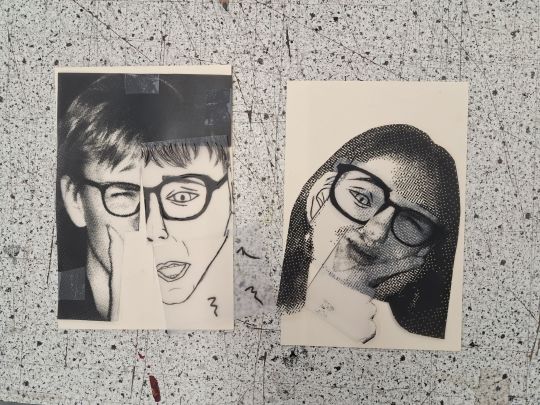





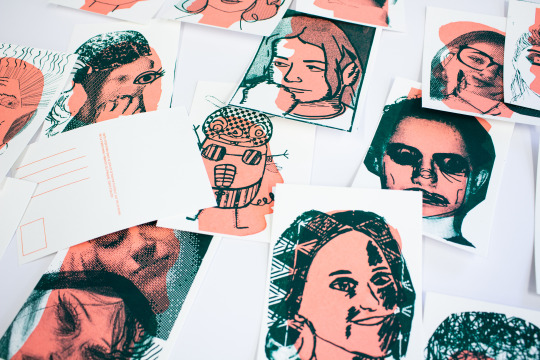
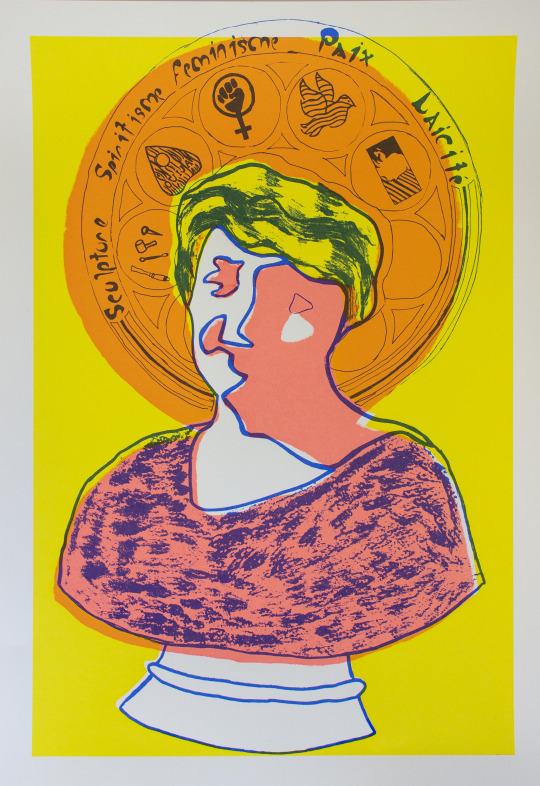
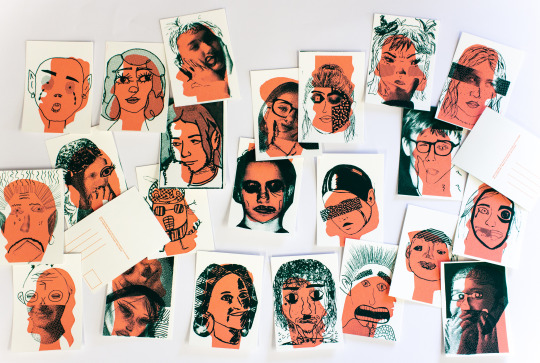
Portraits Lycée de Morez
Cordée de la réussite
Le 2 février 2023, les lycéens du lycée Victor Bérard sont venus imprimer 4 affiches et une série de cartes postales après avoir travaillé autour du portrait en arts plastiques. Ils ont réalisé les portraits de 4 personnalités locales: Marguerite Syamour, Yvonne Clerc, Victor Bérard et Paul-Émile Victor.
Pour s’initier à la sérigraphie, ils ont en parallèle créé une série d’autoportraits mixés sur des formats cartes postales.
#sérigraphie#portraits#autoportraits#atelier#morez#margueritesyamour#yvonneclerc#victorberard#paulemilevictor#jura#histoire
0 notes
Text
Libri per l’estate

Non potevamo certo lasciarvi accaldati per l’afa estiva e assetati di libri da gustare in vacanza! Ecco dunque una puntata fresca fresca di questa ormai consolidata rubrica di consigli letterari.
Iniziamo con due classici.

Processi verbali di Federico De Roberto: estremamente interessante l’esperimento di realismo verista di queste novelline (come le chiama l’autore nella sua concisa e lucidissima prefazione), che ricordano il Verga del ciclo dei vinti (folgorante in questo senso Il rosario), con il ricorso ai proverbi popolari (tanto va la secchia al pozzo, finché si rompe; carcere, malattia, necessità, si conosce l’amistà), con squarci di storia (il ’48 a Napoli e la rivolta di Bronte ne I vecchi), ma anche Pirandello e Guy de Maupassant, per non parlare di Lupetto, che sembra addirittura anticipare Raymond Carver. Esilarante e boccaccesco, un autentico gioiellino, il racconto di chiusura Il viaggio a San Vito.
Il denaro di Émile Zola: un’analisi acuta e quanto mai attuale del mondo degli affari e della Borsa. Imperi economici acquisiti e persi in un sol giorno, i re della finanza ossequiati e riveriti, i falliti derisi e respinti. In una sorta di eterno ritorno le azioni umane si riproducono ciclicamente senza lasciare l’insegnamento necessario a evitare il ripetersi degli errori. Così questo affresco della Borsa francese durante il Secondo impero ricorda le recenti bolle finanziarie che hanno causato la rovina di migliaia di piccoli risparmiatori e il crollo dei mutui fondiari. A manovrare i movimenti di una banca fantasma nata grazie alla complicità di diversi prestanome è il visionario Saccard, a cui il lettore (e con lui diverse figure femminili e un’infinita serie di dipendenti del gioco) si affeziona nonostante tutto e di cui segue le mosse con apprensione e ininterrotta curiosità per quasi 600 pagine che scorrono veloci come un fiume in piena, il fiume del denaro (l’argent del titolo) che passa per le mani di affaristi e speculatori, ma spesso solo in forma virtuale. La cosa più sorprendente è che lo spunto per la trama è tratto da un episodio realmente accaduto: la parabola del banchiere Paul Eugène Bontoux e della banca Union Générale fallita nel 1882. Se il denaro è il tema principale, questo romanzo appartiene pur sempre al ciclo dei Rougon-Macquart ed esplora le tare genetiche che, nella visione deterministica del naturalismo francese, minano la famiglia e ne spiegano i comportamenti. Victor, il figlio perverso e deforme del protagonista, ricorda ‘Coniglio mannaro’, uno degli ultimi discententi dell’indimenticabile famiglia Scacerni de Il mulino del Po di Riccardo Bacchelli. E non poteva mancare neppure il tema dell’antisemimitismo, caro all’autore del J’accuse. Insomma un piatto completo, per gli amanti della buona letteratura.
Non possiamo tralasciare l’ultimo Simenon pubblicato da Adelphi, Il dottor Bergelon: “Qualcosa si era guastato, senza che lui riuscisse a capire cosa”. La verità è che un fatto increscioso, una malaugurata deviazione dalla consueta routine ha avvelenato la pace interiore del protagonista al punto da fargli mettere in discussione l’intera sua esistenza. Affrontare Simenon è sempre come scendere negli abissi più profondi dell’animo umano.

Per chi avesse la fortuna di non aver mai letto Manuel Vázquez Montalbán, sono stati appena ristampati Le terme e Il labirinto greco in cui l’investigatore Pepe Carvalho esprime al meglio le sue doti culinarie e il suo fiuto per le indagini, il tutto in uno stile degno del grande Chandler.

Uno degli autori prediletti di Andrea G. Pinketts, Stuart Kaminsky, professore di storia e critica cinematografica alla Northwestern University di Evanstone, Illinois, farcisce con le proprie competenze letterarie e cinematografiche i suoi gialli hard boiled, per cui Bela Lugosi e William Faulkner diventano clienti del detective privato Toby Peters (“affettuosa parodia dell’investigatore della scuola dei duri”, da Hardboiled blues di Gian Franco Orsi) in due casi che si intrecciano in Never cross a Vampire. Gli amanti del noir potranno cogliere in queste pagine spunti per rivedere vecchi film o scoprirne di nuovi e introvabili. Così anche per Una pallottola per Errol Flynn, Il caso Howard Hughes e Follie di Hollywood, ma nei suoi gialli troviamo molte altre star, come Mae West, Gary Cooper, Clark Gable, Buster Keaton, Judy Garland e Raymond Chandler: pare proprio che il mondo del cinema sia una inesauribile fonte di ispirazione.

Fedele all’idea che uno scrittore dovrebbe trattare di ciò che conosce, nel creare i personaggi Kaminsky non esita a inserire cenni autobiografici, come le radici russe per l’ispettore Rostnikov (Morte di un dissidente: “Le sue armi: una falce, un martello e una bottiglia di vodka”), e la fede ebraica per il poliziotto Abe Lieberman, che opera in una Chicago quanto mai violenta e movimentata (La follia di Lieberman), città d’origine dello scrittore. Infine il detective Lew Fonesca, trasferitosi da Chicago (Midnight Pass) nell’atmosfera assolata e apparentemente pacifica della Florida, specializzato nella ricerca di persone scomparse (Cattive intenzioni, Parole al vento). Notevoli le collaborazioni con il regista Don Siegel per Ispettore Callaghan, il caso Scorpio è tuo, e con Sergio Leone per i dialoghi di C’era una volta in America. Insomma uno scrittore prolifico (possiamo contare una sessantina di titoli) per amanti del cinema, della letteratura e di uno stile ironico e versatile.

Un altro libro ambientato nella Hollywood degli anni d’oro: Perché corre Sammy?, di Budd Schulberg, Oscar alla migliore sceneggiatura originale per Fronte del porto, sceneggiatore di Il paradiso dei barbari con un esordiente Peter Falk e soggettista di Un volto nella folla di Elia Kazan e di Il colosso d’argilla con Humphrey Bogart.
“Quello che mi faceva infuriare era che Sammy era la persona più scaltra e più ottusa che avessi mai conosciuto. Era dotato di un’intelligenza che era in grado di impiegare unicamente a vantaggio di Sammy Glick. È un tipo di intelligenza che comporta una certa ottusità: una specie di sterminata zona d’ombra con un solo raggio di luce diritto davanti a se stessi”.
Ma chi è Sammy? Un arrivista, un arrampicatore sociale, con meno scrupoli che talento, di un cinismo disarmante, egoista e avido, anche le sue apparenti qualità sono solo difetti astutamente mascherati: “un piccolo fattorino ebreo sempre di corsa che diventa un potente produttore, sacrificando ogni cosa d’umano alla sua assetata ambizione”. Consigliato da Kurt Vonnegut (a sua volta scrittore ammirato da Umberto Eco), che addirittura lo paragona a Francis Scott Fitzgerald, è una lettura scorrevole e moderna che ci lascia agganciati al mistero di questo personaggio odioso e intraprendente fino all’ultima pagina. C’è, naturalmente, molto di autobiografico nelle opere di Schulberg: “Figlio del tycoon della Paramount, e lui stesso, per un certo tempo, prediletto di Hollywood... ma anche comunista inciampato nelle reti del Mccarthismo, spesso e volentieri elesse il mondo di Hollywood quale osservatorio ideale... I disincantati si concentra su come muore, in America, una leggenda. Uno scrittore grande e dimenticato, che ha avuto tutto, ed è stato travolto assieme a un mondo lussureggiante dalla crisi del ’29, si lascia umiliare e consumare nel corpo e nella dignità in un ultimo infimo lavoro da sceneggiatore di filmetti”. In questo caso l’episodio autobiografico si riferisce all’incontro di Schulberg con Scott Fitzgerald, chiamato dagli studios a collaborare alla revisione di una sua sceneggiatura.

Il 22 giugno 2022 potrete assistere alla presentazione del romanzo di Manuela Cattaneo della Volta e Livio Sposito, Un cuore al buio: Kafka, che si terrà presso la biblioteca Valvassori Peroni. Il libro racconta la “storia e la vita delle cinque donne che hanno amato Franz Kafka”.

Buone vacanze da tutto lo staff delle biblioteche di Milano!
#federico de roberto#Emile Zola#Riccardo Bacchelli#Georges Simenon#manuel vazquez montalban#pepe carvalho#stuart kaminsky#andrea pincketts#budd schulberg#elia kazan
16 notes
·
View notes
Photo

Harry Baur in Les Misérables (Raymond Bernard, 1934) Cast: Harry Baur, Charles Vanel, Florelle, Josseline Gaël, Gaby Triquet, Jean Servais, Orane Demazis, Gilberte Savary, Charles Dullin, Marguerite Moreno, Émile Genevois, Robert Vidalin, Paul Azaïs, Max Dearly, Henry Krauss. Screenplay: Raymond Bernard, André Lang, based on a novel by Victor Hugo. Cinematography: Jules Kruger. Production design: Lucien Carré, Jean Perrier. Music: Arthur Honegger. Harry Baur gives one of the great film performances in Les Misérables, beginning with a tour de force in the first installment, subtitled Tempest in a Skull, in which he plays not only the brutish convict Jean Valjean and his first assumed identity, the benevolent mayor of Montreuil-sur-Mer, M. Madeleine, but also the addle-brained Champmathieu, wrongly fingered as the fugitive Valjean. Baur's Valjean is not the dashing, younger heroic figure embodied by Fredric March in Richard Boleslawski's 1935 Hollywood version or Hugh Jackman in Tom Hooper's 2012 film of the musical. March and Jackman had to work hard to suggest Valjean's hardened convict past, but Baur looks the part. He cleans up nicely, though. Raymond Bernard's version is closer to the epic Victor Hugo novel than the later adaptations, which necessitates its miniseries length: a 281-minute total run time, divided into three films. Trilogies typically sag in the middle: In Peter Jackson's Lord of the Rings, for example, The Two Towers (2002) is weaker than The Fellowship of the Ring (2001) and The Return of the King (2003). But Bernard manages to give each part fairly equal heft, concentrating on Valjean's transformation in Tempest in a Skull, on the thwarted manipulations of the titular couple in The Thénardiers, and on the fight on the barricades in Freedom, Dear Freedom. This is not to say that there isn't some slackness within each installment: Bernard, like many directors who mastered their skills making silent films, doesn't seem fully at home with sound even yet; there are scenes in which the actors seem to be holding a pose a beat or two longer than necessary. And despite Arthur Honegger's distinguished score, Bernard allows some scenes that could use the "sweetening" of background music to go without it. In The Thénardiers, for example, the plot to ensnare Valjean and the ensuing fight scene could have used some tension-and-release music, but the score only begins, rather abruptly, when the lovers, Marius (Jean Servais) and Cosette (Josseline Gaël), meet. But as a totality, Les Misérables is a triumph, and apparently a little-known one, to judge by the fact that it doesn't come up as one of the top results in an IMDb search. Jules Kruger's cinematography gives an expressionist tilt to some of its scenes, and the production design, from the slummy haunts of the Thénardiers to the opulence of Gillenormand's mansion, is superb. But most of all it has Baur and a tremendous supporting cast, particularly Florelle* as a very touching Fantine, and Émile Genevois as a memorable Gavroche. Charles Vanel's Javert is not humanized sufficiently in the script, I think, so that his suicide comes as something of an anticlimax, but he gives it all the implacable menace the role allows him. But it's Baur who carries the film as impressively as he carries Servais's Marius through the sewers in the climax.
*Her full name was Odette Elisa Joséphine Marguerite Rousseau, and she was occasionally billed as Odette Florelle. It's too bad that today her screen name sounds like an air freshener.
3 notes
·
View notes